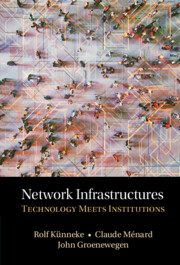Book contents
- Network Infrastructures
- Network Infrastructures
- Copyright page
- Dedication
- Contents
- Figures and Tables
- Preface
- Introduction
- Part I Conceptual Framework
- 1 Network Infrastructures
- 2 Institutional Embeddedness
- 3 Technology in Three Dimensions
- 4 Bringing Together Two Worlds Apart
- Part II Empirical Explorations
- Glossary
- References
- Index of Names
- Subject Index
3 - Technology in Three Dimensions
Economics Meets Systems Engineering
from Part I - Conceptual Framework
Published online by Cambridge University Press: 02 December 2021
- Network Infrastructures
- Network Infrastructures
- Copyright page
- Dedication
- Contents
- Figures and Tables
- Preface
- Introduction
- Part I Conceptual Framework
- 1 Network Infrastructures
- 2 Institutional Embeddedness
- 3 Technology in Three Dimensions
- 4 Bringing Together Two Worlds Apart
- Part II Empirical Explorations
- Glossary
- References
- Index of Names
- Subject Index
Summary
This chapter identifies the technological features of network infrastructures that are relevant for safeguarding their critical functions. Our approach pushes further the economic analysis of the technological dimension of network infrastructures by taking on board important lessons from systems engineering literature. Doing so allows a better understanding of the issues of coordination among the complex combinations of artefacts that provide the physical foundations of infrastructures. Different technological layers are identified and characterized, based on the degree to which the purpose of network infrastructures is specified. The layer “architecture” is typified by the constitutive features of network infrastructures, related to the generic services provided, the constitutive material components, and the basic technological arrangements for safeguarding critical functions. The layer “technological designs” articulates the contextual framing of a generic architecture related to the provision of specific services, material components, and technological arrangements. Lastly, the layer “technical operation” is characterized by the actual processing of technological devices and arrangements so that services are physically provided. In this way, our approach provides an integrated view of the relevant technological features of network infrastructures that can be related to the corresponding institutional characteristics.
Keywords
- Type
- Chapter
- Information
- Network InfrastructuresTechnology meets Institutions, pp. 76 - 92Publisher: Cambridge University PressPrint publication year: 2021



